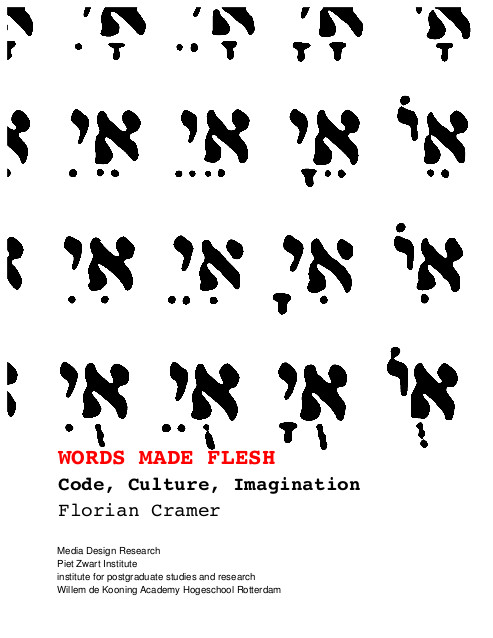Anna Bentkowksa-Kafel, Trish Cashen, Hazel Gardiner (eds.): Futures past: thirty years of arts computing (2007)
Filed under book | Tags: · art history, digital art, software art

In decades past, artists envisioned a future populated by technological wonders such as hovercraft vehicles and voice-operated computers. Today we barely recognize these futuristic landscapes that bear only slight resemblance to an everyday reality. Futures Past considers digital media’s transformative impact on the art world from a perspective of thirty years’ worth of hindsight. Herein a distinguished group of contributors—from researchers and teachers to curators and artists—argue for a more profound understanding of digital culture in the twenty-first century.
This unprecedented volume examines the disparities between earlier visions of the future of digital art and its current state, including frank accounts of promising projects that failed to deliver and assessments of more humble projects that have not only survived, but flourished. Futures Past is a look back at the frenetic history of computerized art that points the way toward a promising future.
Published by Intellect Books, 2007
ISBN 1841501689, 9781841501680
128 pages
Key terms:
ARTstor, ontologies, Semantic Web, UCSD, iconography, art history, WordNet, digital art, Toyo Ito, Charles Rufus Morey, Princeton University, Kersale, synsets, University of Birmingham, Christian Art, Georg Nees, Medieval Art, software art, Jean Nouvel, intranet
More info (google books)
More info (publisher)
Digital Artists’ Handbook (2009)
Filed under manual | Tags: · digital art, floss, free software, graphics, software, software art, sound recording, video

The Digital Artists Handbook is an up to date, reliable and accessible source of information that introduces you to different tools, resources and ways of working related to digital art.
The goal of the Handbook is to be a signpost, a source of practical information and content that bridges the gap between new users and the platforms and resources that are available, but not always very accessible. The Handbook will be slowly filled with articles written by invited artists and specialists, talking about their tools and ways of working. Some articles are introductions to tools, others are descriptions of methodologies, concepts and technologies.
When discussing software, the focus of this Handbook is on Free/Libre Open Source Software. The Handbook aims to give artists information about the available tools but also about the practicalities related to Free Software and Open Content, such as collaborative development and licenses. All this to facilitate exchange between artists, to take away some of the fears when it comes to open content licenses, sharing code, and to give a perspective on various ways of working and collaborating.
Contents: Graphics; Working with sound; Working with others; Publishing your work; Working with digital video; Software art; Developing your own hardware.
Produced by folly and GOTO10
Creative Commons Attribution-Noncommercial-Share Alike 2.0 UK: England & Wales License
228 pages
PDF (updated on 2013-10-17)
View online (HTML articles, updated on 2013-10-17)
Florian Cramer: Words Made Flesh: Code, Culture, Imagination (2005)
Filed under book | Tags: · art, art history, code, code poetry, computation, experimental literature, kabbalah, language, literature, philosophy, poetry, religion, software, software art, technology

“Executable code existed centuries before the invention of the computer in magic, Kabbalah, musical composition and experimental poetry. These practices are often neglected as a historical pretext of contemporary software culture and electronic arts. Above all, they link computations to a vast speculative imagination that encompasses art, language, technology, philosophy and religion. These speculations in turn inscribe themselves into the technology. Since even the most simple formalism requires symbols with which it can be expressed, and symbols have cultural connotations, any code is loaded with meaning. This booklet writes a small cultural history of imaginative computation, reconstructing both the obsessive persistence and contradictory mutations of the phantasm that symbols turn physical, and words are made flesh.”
Editor: Matthew Fuller, additional corrections: T. Peal
Published within Media Design Research programme, Piet Zwart Institute, Willem de Kooning Academy Hogeschool, Rotterdam
GNU General Public License 2; GNU Free Documentation License 1.2; Creative Commons Attribution-ShareAlike License 2.0
141 pages
Review: Tomáš Javůrek (Joinme, 2018, CZ).
PDF (updated on 2012-10-11)
HTML (added on 2013-7-1)
Sequel: Exe.cut(up)able statements: Poetische Kalküle und Phantasmen des selbstausführenden Texts (2011, in German).
Comment (0)
